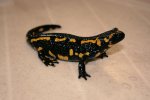vide
Member
- Joined
- May 7, 2007
- Messages
- 48
- Reaction score
- 3
- Points
- 8
- Age
- 43
- Location
- Uppsala
- Country
- Sweden
- Display Name
- Vide Ohlin
Hi all!
I’m having trouble with my Salamandra s. terrestris and could use some advise.
A couple of weeks ago I noticed that here skin seemed dry and it had a greyish hue. Now, when I got back from my ester vacation it had gotten a lot worse. Some of the yellow spots are hardly visible and the skin seams very dry and a bit wrinkled. If you rub the skin lightly the black comes of, so it’s only in the top layer. Also she walks a bit funny, lifting here tail in an unusual way. Although she is still interested in food she is not as alert as usual.
If it is some kind of fungus should I then try treating with a salt solution? Are there other fungicides I should try? I hope someone has seen this before and know how to treat it… Thanks in advance!
Meanwhile my T. marmoratus are laying eggs so it’s not all miseries..!
/ Vide Ohlin
I’m having trouble with my Salamandra s. terrestris and could use some advise.
A couple of weeks ago I noticed that here skin seemed dry and it had a greyish hue. Now, when I got back from my ester vacation it had gotten a lot worse. Some of the yellow spots are hardly visible and the skin seams very dry and a bit wrinkled. If you rub the skin lightly the black comes of, so it’s only in the top layer. Also she walks a bit funny, lifting here tail in an unusual way. Although she is still interested in food she is not as alert as usual.
If it is some kind of fungus should I then try treating with a salt solution? Are there other fungicides I should try? I hope someone has seen this before and know how to treat it… Thanks in advance!
Meanwhile my T. marmoratus are laying eggs so it’s not all miseries..!
/ Vide Ohlin



